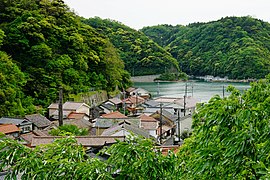|
Ōda, Shimane
   Ōda (大田市, Ōda-shi) is a city in Shimane Prefecture, Japan.[1] The city has a total area of 436.11 km2. As of 1 December 2022[update], the city had an estimated population of 32,838 in 15557 households and a population density of 75 persons per km2.[2] The total area of the city is 435.71 square kilometres (168.23 sq mi). Ōda is home to the Iwami Ginzan Silver Mine, a World Heritage Site.[1] GeographyLocated in the central coastal portion of Shimane Prefecture, Ōda borders the Sea of Japan to the north and the Chūgoku Mountains to the south. Mount Sanbe (1,126 metres (3,694 ft)), part of Daisen-Oki National Park, is a double volcano of the Hakusan Volcanic Zone, and is situated to the southeast of the city.[1] Neighboring municipalitiesShimane Prefecture ClimateŌda has a humid subtropical climate (Köppen climate classification Cfa) with very warm summers and cool winters. Precipitation is abundant throughout the year. The average annual temperature in Ōda is 15.3 °C (59.5 °F). The average annual rainfall is 1,772.8 mm (69.80 in) with July as the wettest month. The temperatures are highest on average in August, at around 27.0 °C (80.6 °F), and lowest in January, at around 5.0 °C (41.0 °F).[3] The highest temperature ever recorded in Ōda was 39.2 °C (102.6 °F) on 6 August 2021; the coldest temperature ever recorded was −7.5 °C (18.5 °F) on 26 February 1981.[4]
DemographicsPer Japanese census data, the population of Ōda in 2020 is 32,846 people.[5] Ōda has been conducting censuses since 1920.
HistoryMost of the area of present-day Ōda is located in Iwami Province, although an eastern portion of the city was within the borders of Izumo Province. The area was a meeting point of three ancient transportation routes: the San'indō, Izumo Kaidō, and the Bingo Kaidō. As a result, numerous market towns were developed in the area.[1] With the development of the Iwami Ginzan Silver Mine, the area was maintained as tenryō, or territory under the direct control of the Tokugawa shogunate, throughout the Edo Period. The village of Ōda within Ano District, Shimane, was established on April 1, 1889 with the creation of the modern municipalities system. Ōda was raised to town status on November 6, 1903. Ōda merged with the neighboring villages of Nagahisa, Torii, Kute, Hanehigashi, Kawai, Shizuma, and Kuri on November 1, 1954 and was raised to city status. On October 1, 2005, the towns of Nima and Yunotsu (both from Nima District) were merged into Ōda. Therefore, Nima District was dissolved as a result of this merger. GovernmentŌda has a mayor-council form of government with a directly elected mayor and a unicameral city council of 18 members. Ōda contributes two members to the Shimane Prefectural Assembly. In terms of national politics, the city is part of the Shimane 2nd district of the lower house of the Diet of Japan. EconomyŌda remains a center of agricultural production. The city is a center for dairy farms. Fisheries (commercial fishing, seafood processing), roof tile manufacturing (Sekishu roof tiles), and tourism are also mainstays of the local economy.[1] EducationŌda has 16 public elementary schools and six public junior high schools operated by the city government, and two public high schools operated by the Shimane Prefectural Board of Education. TransportationRailway
HighwaysSister cities
Local attractionsIwami Ginzan Silver MineŌda is home to the Iwami Ginzan Silver Mine, a World Heritage Site. Iwami Ginzan was the largest silver mine in Japanese history. Active for almost four hundred years, it operated from the discovery of silver in the area in 1526 until 1923. Iwami Ginzan was the most important source of silver to the Tokugawa Shogunate during the Edo period (1603 – 1868), and was directly controlled by the Tokugawa government. The mine is a popular tourist destination in Shimane, and can be reached by bus from Ōda Station on the JR West Sanin Main Line.[1] Mononobe ShrineThe Mononobe Shrine is the ichinomiya of former Iwami Province. Nima Sand MuseumThe Nima Sand Museum features a large hourglass mechanism that automatically rotates from December 31 to January 1. It is designated the largest hourglass in the world, but is not officially registered in Guinness World Records. This museum officially opened in March 1991.[6] References
External linksWikimedia Commons has media related to Oda, Shimane.
|
|||||||||||||||||||||||||||||||||||||||||||||||||||||||||||||||||||||||||||||||||||||||||||||||||||||||||||||||||||||||||||||||||||||||||||||||||||||||||||||||||||||||||||||||||||||||||||||||||||||||||||||||||||||||||||||||||||||||||||||||||||||||||||||





